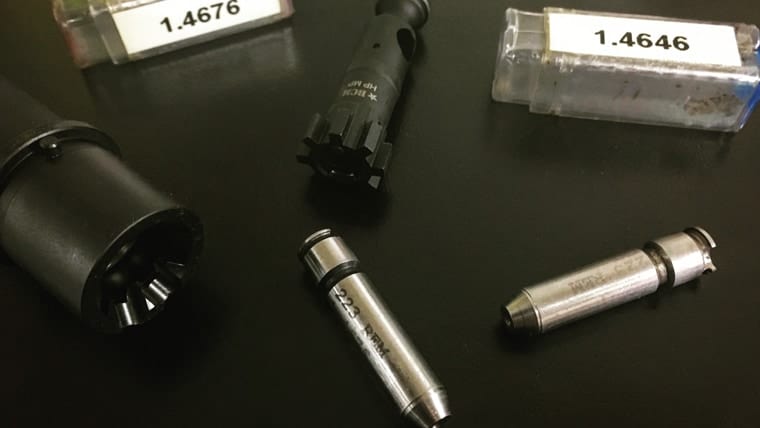Join the Hide community
Get access to live stream, lessons, the post exchange, and chat with other snipers.
Register
Download Gravity Ballistics
Get help to accurately calculate and scope your sniper rifle using real shooting data.

Install the app
How to install the app on iOS
Follow along with the video below to see how to install our site as a web app on your home screen.
Note: This feature may not be available in some browsers.
You are using an out of date browser. It may not display this or other websites correctly.
You should upgrade or use an alternative browser.
You should upgrade or use an alternative browser.
Shouldered Pre-fit Barrel Saftey Check
- Thread starter JohnSnark
- Start date
You don’t need the field gauge, but the other two will do. Some just buy the go gauge and then use scotch tape or similar to create their own No-go. For most cases the difference between no go and go is about 4 to 5 thou
Last edited:
Why not get all three? I would argue that with a shouldered prefit you don't really need a "Go" gauge because you are not trying to set headspace like you would be doing on a barrel nut setup. On a shouldered prefit you are really just checking for/making sure you don't have dangerously excessive headspace. A rifle can fail a "NO GO" gauge and still be safe to shoot. If you fail a "NO GO" test your next step is to check it with a "Field" gauge If it fails a "Field" gauge test you definitely don't want to shoot it, but if it passes a "Field" gauge test I would be ok shooting it. IMO the names of the gauges should be
"GO" = "Ideal headspace"
"NO GO" = "Headspace on the plus side"
"Field" "Dangerously excessive headspace do not shoot"
"GO" = "Ideal headspace"
"NO GO" = "Headspace on the plus side"
"Field" "Dangerously excessive headspace do not shoot"
I like using a go gauge and brass shims cut to the size of the bolt face. I want it to fall on the go, and when I add .002-.003" I want it to start to fall but not all the way.
I wouldn't be happy with a prefit that allowed the bolt to close on a nogo.
I wouldn't be happy with a prefit that allowed the bolt to close on a nogo.
I bought a very slightly used AI AX 308 and I already had a set of gauges so I checked head space the bolt will close on the "NOGO", but it will not close on the "Field" gauge. Can't say I was happy with that, but it does shoot 1/2 MOA or less and the fired brass shows no sign of excessive wear so I am ok with it. I bought a 6.5CM barrel for it and the bolt will not close on the "No Go" gauge.I wouldn't be happy with a prefit that allowed the bolt to close on a nogo
I use some shims made from feeler gage blades, cut to fit bolt head. Ive got a .001, .002, .0025, .003, .004, and .005. When I spin on a barrel with barel nut or a shouldered prefit, I can record what it is and compare later on. Also makes it easy to get back to original headspace on a barrel nut prefit that gets switched, so previous brass caes fit.
So you don't size your own brass?Because I use only my own handloads and brass processed by others, I wouldn't want the headspace to be less than go since processors aim for '0' headspace - i.e., exactly what the go gauge is.
You could have a barrel set at "0" h/s and still have no issues with factory or even handloads. Factory ammo is usually about .005" under a Go gage at the shoulder. When you reload, you bump the shoulder about .002" to feed reliably.
Right. I headspace the barrels with a piece of tape under the go gauge to do just that.
I was pointing out that I would want to use a go and no go gauge in headspacing - not just a no go gauge. Without using the go gauge, you don't know whether the headspace is below 0.
I was pointing out that I would want to use a go and no go gauge in headspacing - not just a no go gauge. Without using the go gauge, you don't know whether the headspace is below 0.
Some things I do with prefits
Measure stand out of go gauge from breech of barrel.
Measure depth of bolt from boltface to most forward point.
Seat barrel and check with go gauge.
Add layers of clear packing tape to rear of go gauge till Bolt won’t close.
That tape is .002 thick so optimally(in my opinion) no more than one or two layers to stop bolt closing.
Measure stand out of go gauge from breech of barrel.
Measure depth of bolt from boltface to most forward point.
Seat barrel and check with go gauge.
Add layers of clear packing tape to rear of go gauge till Bolt won’t close.
That tape is .002 thick so optimally(in my opinion) no more than one or two layers to stop bolt closing.
Thanks everyone. Lots of good info. Just to clarify, my concern is safety. It seems to me that checking the headspace for safety reasons on a new shouldered pre-fit barrel would be a good idea. How do I know the shop didn't mess my order up, or the smith didn't make a mistake? I am trusting my life/safety with people I don't know.
Shoot one case and measure stretch or try a go gauge with tape or no go gauge.
If it passes that it’s GTG.
Unless it stretches the case grossly it’s safe.
Even if it stretches 10 thou it’s safe as long as your not planning on reloading the brass.
1-4 thou stretch is good.
If it passes that it’s GTG.
Unless it stretches the case grossly it’s safe.
Even if it stretches 10 thou it’s safe as long as your not planning on reloading the brass.
1-4 thou stretch is good.
What is your concern exactly?Thanks everyone. Lots of good info. Just to clarify, my concern is safety. It seems to me that checking the headspace for safety reasons on a new shouldered pre-fit barrel would be a good idea. How do I know the shop didn't mess my order up, or the smith didn't make a mistake? I am trusting my life/safety with people I don't know.
What is your concern exactly?

What is Headspace and Why Should it be Checked? - Criterion Barrels
Few tolerances found on a firearm are of more importance than headspace. Not only is headspace essential to rifle accuracy, but it is a major safety factor to consider when assembling a firearm.
 criterionbarrels.com
criterionbarrels.com

Headspace Gages – Forster Products
Forster offers three lengths of headspace gages for most rifle calibers, in order from shortest to longest:
- GO: Corresponds to the minimum chamber dimensions. If a rifle closes on a GO gage, the chamber will accept ammunition that is made to SAAMI maximum specifications. The GO gage is essential for checking a newly-reamed chamber in order to ensure a tight, accurate, and safe chamber that will accept SAAMI maximum ammo.
- NO-GO: Corresponds to the maximum headspace we recommend for gunsmiths’ chambering new bolt-action rifles. This is not a SAAMI-maximum measurement. If a rifle closes on a NO-GO gage, it may still be within SAAMI specifications, or it may have excessive headspace. To determine if there is excessive headspace, the chamber should then be checked with a FIELD gage. The NO-GO gage is a valuable tool for gunsmiths’ reaming new chambers, in order to ensure tight and accurate headspace.
- FIELD: Corresponds to the longest safe headspace. If a rifle closes on a FIELD gage, its chamber is dangerously close to, or longer than, SAAMI-specified maximum chamber size. If chamber headspace is excessive, the gun should be taken out of service until it has been inspected and repaired by a competent gunsmith. FIELD gages are slightly shorter than the SAAMI maximum in order to give a small safety margin.
This whole thread is aimed at helping you check headspace. Buy the gauges, install the barrel, check headspace, shoot gun. Really is that simple.
What is Headspace and Why Should it be Checked? - Criterion Barrels
Few tolerances found on a firearm are of more importance than headspace. Not only is headspace essential to rifle accuracy, but it is a major safety factor to consider when assembling a firearm.criterionbarrels.com
Similar threads
- Replies
- 54
- Views
- 1K
- Replies
- 3
- Views
- 756
- Replies
- 4
- Views
- 301
- Replies
- 1
- Views
- 189
